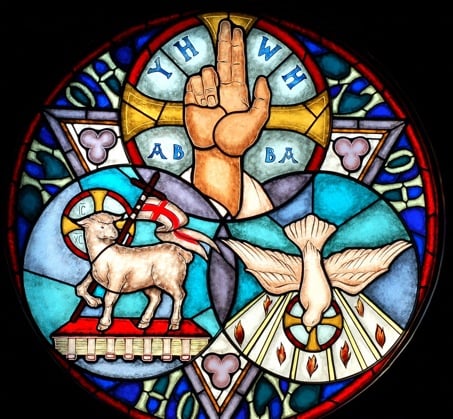The Maker's Mark
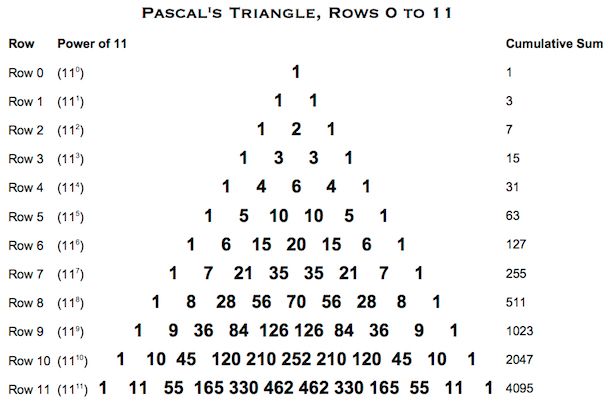
Pascal's triangle is the most revered object in mathematics. This deceptively simple array of numbers has a multitude of important properties and applications and was known to ancient Chinese and Indian mathematicians. In the 17th Century its properties were studied in depth by Blaise Pascal and it has been an object of fascination to mathematicians ever since. New properties are still being discovered, in fact, and one recent find, a formula for calculating cubes within the triangle, is of key importance to the New Bible Code.
The image above shows the triangle in its usual form, with the numbers cascading down from the apex. The entire triangle is created from an initial '1' by treating the blank spaces either side of it as zeros. Each number on the array is then formed by the simple rule of adding any two adjoining numbers and placing the sum below and between them, which is what gives the array its triangular form. The rows have been numbered here (note that they begin with row 0) and two important features of the triangle displayed:
1) each row can be read as a power of 11, which is shown in the left-hand column, and
2) the sum to each row, counting down from the apex, is shown in the right-hand column.
These are essential aids to a full understanding of what is to follow.
This page details a startling series of correlations between Pascal's triangle, English and Hebrew gematria and the New Bible Code, showing how the structure of the English alphabet and all four systems of gematria employed by the code are rooted in the fertile soil of Pascal's famous array. These correlations encourage us to dig around the apex of the triangle, where we uncover gemstones that translate through two systems of gematria into the two most potent names for God in two languages: and which stand together as a double witness to God's reality and omnipotence.
This is the Maker's Mark on the New Bible Code.
Pascal's Triangle and the English Alphabet
Last year I noticed an intriguing correlation between a pattern of numbers found within Pascal's triangle and numbers derived by summing the values of the letters of the English alphabet, under three popular numeration systems I use. I had looked at it after discussions with researcher Leo Tavares, who claims that Hebrew gematria is self-validating, based on the sums and mirror sums of Hebrew letter numerals.
The three popular numeration systems I apply to the English language are given below, along with the individual letter values under each system, the sum of the complete alphabet and the sums of their mirrored values (e.g. 21 becomes 12, 800 becomes 8, etc). The numeration systems are based on three traditional Hebrew methods and used in exactly the same way.
The standard value system (based on the Hebrew Ragil method)
A 1, B 2, C 3, D 4, E 5, F 6, G7, H 8, I 9, J 10, K 20, L 30, M 40, N 50, O 60, P 70, Q 80, R 90, S 100, T 200, U 300, V 400, W 500, X 600, Y 700, Z 800
Sum ..........= 4095
Mirror sum = 126
The ordinal value system (based on the Hebrew ordinal method)
A 1, B 2, C 3, D 4, E 5, F 6, G7, H 8, I 9, J 10, K 11, L 12, M 13, N 14, O 15, P 16, Q 17, R 18, S 19, T 20, U 21, V 22, W 23, X 24, Y 25, Z 26
Sum = ..........351
Mirror sum = 729
The reduced value system (based on the Hebrew Katan method)
A 1, B 2, C 3, D 4, E 5, F 6, G7, H 8, I 9, J 1, K 2, L 3, M 4, N 5, O 6, P 7, Q 8, R 9, S 1, T 2, U 3, V 4, W 5, X 6, Y 7, Z 8
Sum ..........= 126
Mirror sum = 126
What I discovered was that all of these sums and mirror sums are found within rows 0 to 11 of Pascal's triangle, as shown below. Note that the blue outline triangle surrounds numbers summing to 351 and that each vertex is associated with the number 126, twice as numbers and also as the digits of 126 down the spine of Pascal's triangle.
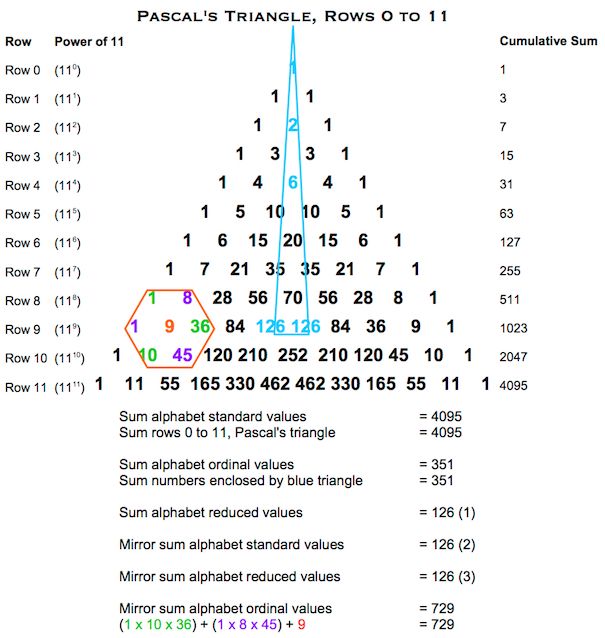
Four of the six alphabet sums define the blue triangle in the centre, which rests on row 9. A fifth alphabet sum, 729, is the cube of 9 and the formula I show for calculating cubes within Pascal's triangle, discovered by Tony Foster, uses a hexagon of numbers centred on row 9. The number 11 is involved too. Each row can be read as a power of 11 and row 9 is 11^9. [1] The first 11 rows contain the final alphabetic sum and row eleven can be read as 11^11. Here we see a clear focus on the numbers 9 and 11. Cube 729 is the basis of the September-11 Cube, which relays the central message of the code, that 9/11 announced Jesus' Second Coming. So these numbers point towards 9/11, indicating how deeply it has been woven into the New Bible Code.
The relationships between these numbers in Pascal's triangle mysteriously reflect their common origin in the English alphabet, from where I just derived them, and speak of a grand design behind the apparent accidents of a 26-letter alphabet, a base-10 counting system and these systems of alphabetic numeration. This is solid evidence that the English language, the English alphabet and the Bible did not blindly evolve, as we might assume, but were the results of a teleological process, the purpose of which was to create a body of encrypted information within the 1984 NIV Bible.
On mirror sums: without them you would have just the standard, ordinal and reduced sums of 4095, 351 and 126. These alone are good evidence for a link between Pascal's triangle and the structure of the English alphabet. But the mirror sums are all there too and including them reveals the true strength of the connection. Pascal's triangle is mirrored either side of its central spine, so the idea of mirroring is found within the triangle itself.
A Fourth System of English Gematria
The fourth system of gematria I use was given to me in 2003, as I began to study Pascal's triangle in relation to the code. [2]. Specifically, it points to rows 0 to 7 of Pascal's triangle, which sum to 255 and which can be divided into a triangular outline summing to 141 and an internal triangle summing to 114. [3] The largest rhombus that can be drawn from the apex sums to 69. These numbers, I soon discovered, are associated with the principle name and title by which we know our Creator in English and Hebrew, found far more often in the Christian and Hebrew Bibles than any other names for our Creator.
1. 255 is the sum of the standard, ordinal and reduced values for 'Lord' in English.
Lord (s) ...............................= 184
Lord (o) .................................= 49
Lord (r) ..................................= 22
184 + 49 + 22 ......................= 255
2. 69 is the sum of the standard, ordinal and reduced values for 'YHVH/the Lord' in Hebrew.
YHVH/the Lord (s) ................= 26
YHVH/the Lord (o) ................= 26
YHVH/the Lord (r) .................= 17
26 + 26 + 17 ..........................= 69
3. 141 is the sum of the standard, ordinal and reduced values for 'Elohim/God' in Hebrew.
Elohim/God (s) .....................= 86
Elohim/God (o) .....................= 41
Elohim/God (r) ......................= 14
86 + 41+ 14 .........................= 141
4. 114 is the sum of the standard, ordinal and reduced values for 'God' in English.
God (s) .................................= 71
God (o) .................................= 26
God (r) ..................................= 17
71 + 26 + 17 .......................= 114
I call this numeration system the combined value, denoted by the letter 'c'. So we have
Lord (c) ..............................= 255
YHVH/the Lord (c) ...............= 69
Elohim/God (c) ...................= 141
God (c) ...............................= 114
The diagram below shows the triangle forming rows 0 to 7 of Pascal's triangle. The sum of its component numbers is 255, combined value of Lord.
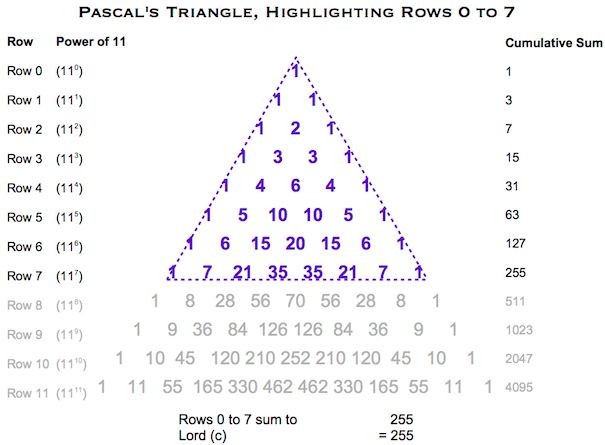
The Hebrew word YHVH/the Lord is the personal name of God, found over 6800 times in the Hebrew Bible and considered the most sacred name of all by the ancient Hebrews. Its combined value of 69 is found as a rhombus within the same triangle.
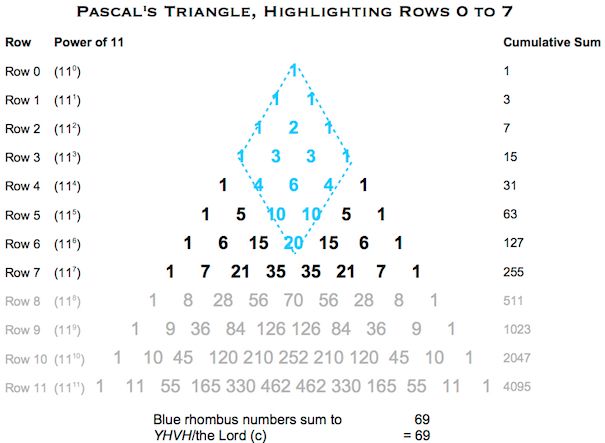
Separating the first sevn rows into a triangular outline summing to 141 and an enclosed triangle summing to 114, we find the combined values of Elohim/God and God.
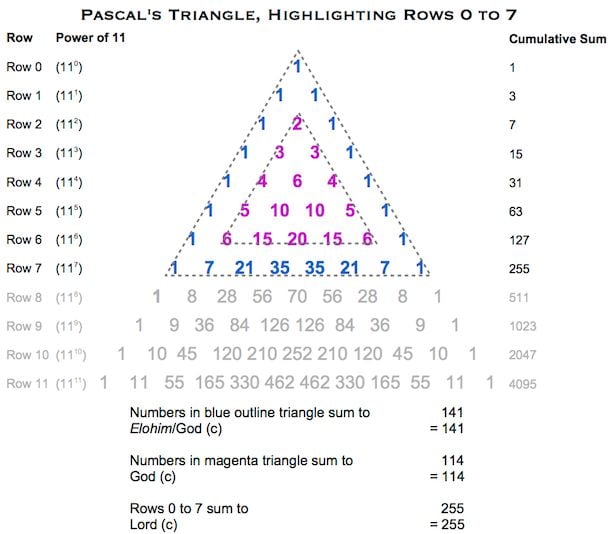
So rows 0 to 7 contain all four combined values!
At the heart of the magenta triangle is a little triangle of three numbers - 6, 10, and 10 - that sum to 26. [4] This is the standard value of YHVH/The Lord.
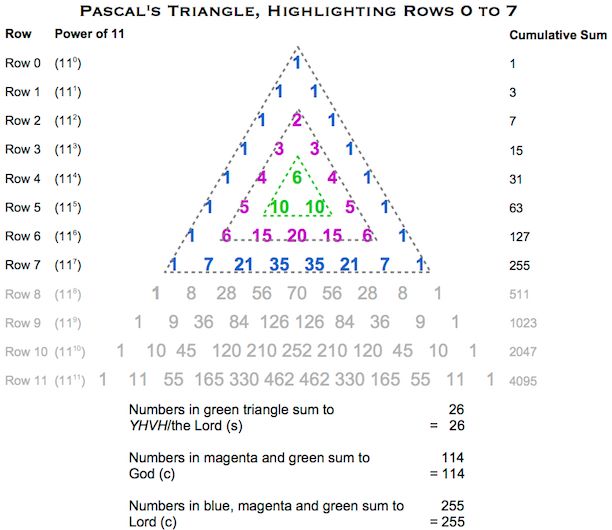
26 is also the the ordinal value of both 'YHVH' and 'God', the number of letters in the English alphabet and the sum of all the numbers from the apex to the '6' heading the little triangle in the centre. [5]
I showed that the combined value of 'Lord' is 255. But this is also the standard value of 'Lord God'!
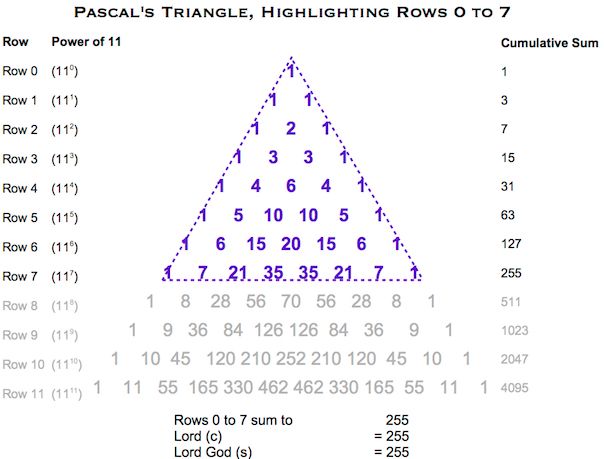
Rows 0 to 7 contain 36 individual numbers, so if we consider each number as a counter we have a representation of triangle 36. 36 is the standard value of HaEl/God (Isa. 42.5) and the Aramaic word Elah/God!
The standard value is first and foremost among all systems of alphabetic numeration and the standard values of 'Lord' and God' are also found individually within rows 0 to 7 . . .
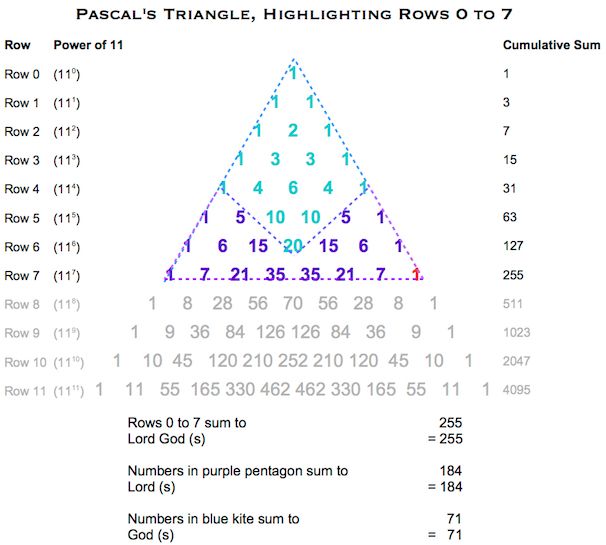
. . . . as are the standard values of the Hebrew names YHVH/the Lord and Elohim/God!
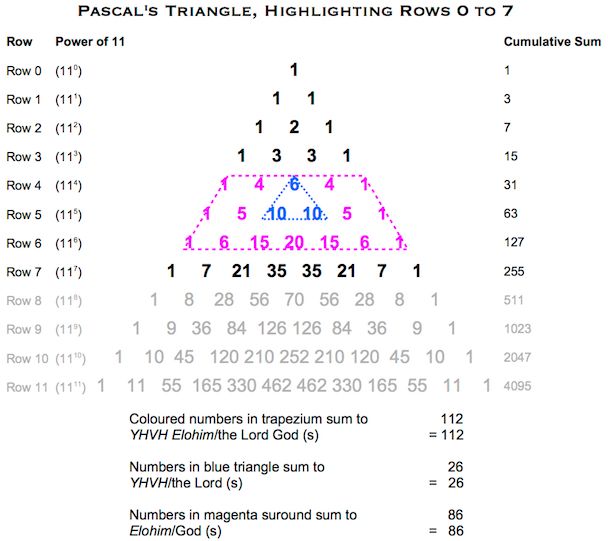
So rows 0 to 7 of Pascal's triangle, viewed through the lens of gematria, are seen to be watermarked with the names 'Lord' and 'God' in the standard and combined numeration systems of both English and Hebrew gematria.
In other words, the two principal designations for our Creator in both English and Hebrew have been encoded with properties belonging to rows 0 to 7 of Pascal's triangle.
The two words, two languages and two systems of numeration are all forms of double witness to the reality of the New Bible Code, reinforcing it's message, revealing its mathematical roots and leading us to the Maker's Mark itself - the hallmark of the code's authenticity - engraved by its Maker near the apex of Pascal's triangle, itself a symbol of another apex we call heaven.
Pascal's Triangle in the Garden
The NIV Bible's first few verses, which I call The Garden, contain a holographic matrix of encodings introducing the code and presenting it as a garden, filled with trefoils (three-leaved plants), snowflakes and other representations of life and growth in our fractal universe. Growing plants in their vegetative phase double in size at a regular rate, giving the geometric sequence 1, 2, 4, 8, 16, . . . . Pascal's triangle also models geometric growth because each row of numbers sums to double the previous row, giving the same sequence: 1, 2, 4, 8, 16, . . . .
This model of geometric growth in relation to plant life will be expanded upon in a future page, but for now I will show you how the basis of the English alphabet in Pascal's triangle is referenced in the Garden. This is a stunning display of the self-referential nature of the New Bible Code and adds to the theme of a garden bursting with life.
Here again are the four systems of alphabetic numeration I use applied to the letters of English alphabet, along with the sums and mirror sums of the complete alphabet under each system.
The standard value system
A 1, B 2, C 3, D 4, E 5, F 6, G7, H 8, I 9, J 10, K 20, L 30, M 40, N 50, O 60, P 70, Q 80, R 90, S 100, T 200, U 300, V 400, W 500, X 600, Y 700, Z 800
Sum ..........= 4095
Mirror sum = 126
The ordinal value system
A 1, B 2, C 3, D 4, E 5, F 6, G7, H 8, I 9, J 10, K 11, L 12, M 13, N 14, O 15, P 16, Q 17, R 18, S 19, T 20, U 21, V 22, W 23, X 24, Y 25, Z 26
Sum = ..........351
Mirror sum = 729
The reduced value system
A 1, B 2, C 3, D 4, E 5, F 6, G7, H 8, I 9, J 1, K 2, L 3, M 4, N 5, O 6, P 7, Q 8, R 9, S 1, T 2, U 3, V 4, W 5, X 6, Y 7, Z 8
Sum ..........= 126
Mirror sum = 126
The combined value system
A 3, B 6, C 9, D 12, E 15, F 18, G 21, H 24, I 27, J 21, K 33, L 45, M 57, N 69, O 81, P 93, Q 105, R 117, S 120, T 222, U 324, V 426, W 528, X 630, Y 732, Z 834
Sum ..........= 4572
Mirror sum = 4662
This now gives four pairs of numbers, calculated under the standard (s), ordinal (o), reduced (r) and combined (c) systems. Every one of these numbers is found within the Garden and in a way that identifies them as pairs. Each numeration system is colour coded.
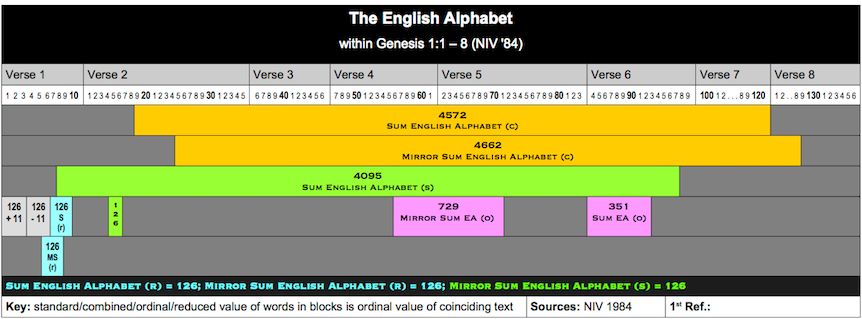
Just finding all eight sums beginning within the first six verses would be a highly unlikely event if the winds of chance were responsible for arranging these word strings, the probability of a random occurrence being around 1 in 13,000. [7] But the chances are reduced even further by the fact that for each numeration system the sums and mirror sums are also relatively close to each other, creating sum/mirror sum pairs (coloured). Like the imprinting of the divine name and title onto Pascal's triangle in both English and Hebrew, the inclusion of both sum and mirror sum in clustered pairs suggests the idea of a double witness to what God has accomplished. For more examples of clustering and the double witness phenomenon see below and here.
I have highlighed in grey another phenomenon I found in the opening nine words: they can be trisected into three substrings of three words, which sum to 137 (126 + 11), 115 (126 - 11) and 126, respectively. This link between 9, 11 and 126 at the very apex of Scripture is surely another reference to Pascal's triangle, each row of which is a power of 11 and which, as we have seen, holds the sums and mirror sums of the English alphabet in rows 9 and 11. The ideas of triangularity and three-ness (3 representing spirit in biblical numerics), already found in Pascal's triangle, are suggested here by the trisection of the opening nine words into 3 x 3 word strings and by the ordinal value of those nine words being 378, the 27th triangular number, 27 being 3 cubed! The numbers 137 (126 + 11) and 115 (126 - 11) cover the first 27 letters.
Within the NIV's first 27 words the numbers 9 and 11 appear, as part of a little sequence of 7, 9 and 11 words. Clustered tightly around the 9-and 11-word strings are the phrases 'Pascal's triangle', 'English Alphabet' and 'English language', all double-witnessed by the use of standard and combined values. The 9-and 11-word strings sum to the standard values of 'Jesus' and 'Christ' (the subject of the New Bible Code), which are double-witnessed by the presence of the combined values. Even the sums of the numbers to rows 9 and 11 on Pascal's triangle are encoded - another kind of double witness!
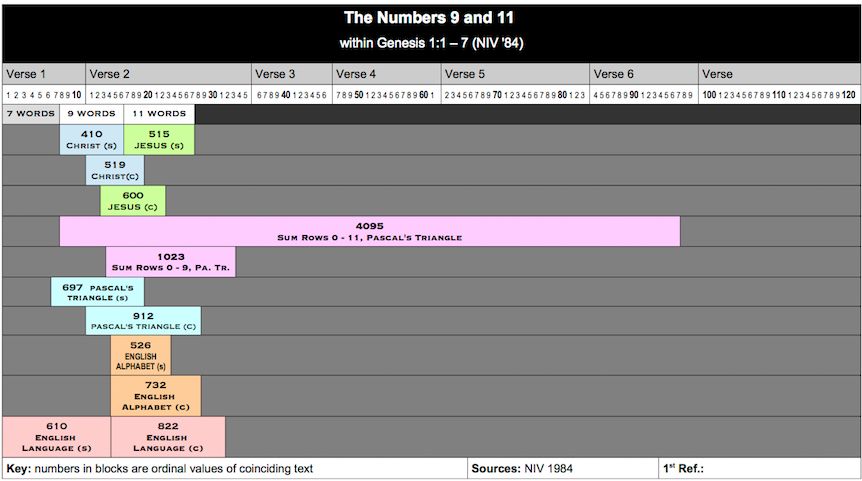
The letters of the English alphabet are the building blocks of the English language. As numbers they are the building blocks of a mathematical code that unlocks the message of 9/11, here fully validated by the inclusion of these related phrases, all double witnessed and forming a tight cluster at the apex of Scripture.
The clustering phenomenon is powerful testimony that the wind of Spirit was blowing through Scripture, not chance, because chance had no way of telling what numbers are related through gematria. In fact the probabilty of all of these word strings starting within the first 17 words of the NIV are somewhere about 1 in 10,000,000. The odds against them also being clustered so closely around the '9/11' word strings must be still greater. There are many alternative words and phrases that could have substituted, of course, but the difference with this cluster is that these words are all meaningfully related within the context of Pascal's triangle and the code. In other words they witness to what has already been found within Pascal's triangle and therefore we can rest assured that they really have been hidden there in the Garden for us to find. The values could have been calculated under other numeration systems and other words and phrases could have been substituted, which would ordinarily reduce the odds considerably. But the Maker's Mark in Pascal's triangle was created from the standard and combined values, so these standard/combined-value pairs in Genesis are obviously referencing them. It is reasonable to assume then that we are meant to decode here using the standard and combined values.
For an indication of what we would expect with random number pairs, see here.
The New Bible Code and the NIV Bible
I had personal reasons for calling the code to which I'd been led the New Bible Code, yet it seems my choice was also preordained. [8] The phenomena of the double witness and clustering come together one more time to form one of the most elegant encodings I have seen, sitting at the precise centre of the Garden, which is the opening five verses of the NIV Bible.

The double witness of the standard and combined values is here doubled again by the ordinal and reduced values to form a water-tight cluster of word strings within the Garden, proclaiming the reality of the New Bible Code, now authenticated from within itself. The chances of these numbers all being found this close to the start of Scripture are about 1 in 16 (1 in 4 for the standard and combined values). However, this does not take account of the tightness of the cluster and the intriguing pattern it makes.
Each pair resembles the letter vav on its side. The letter vav is named after the hooks that bound the curtain to the tabernacle and in Jewish tradition it is the letter that 'hooks' the letters of the Torah to each page, or, more generally, hooks together heaven and earth, the spiritual and the material. [9]
The letter vav must therefore be a reference to the code having been 'hooked' to the NIV Bible.
In this context it is interesting that the combined value of 828 is the standard value of this phrase:
The Spirit of God (s) = 828
In Genesis 1.2 it was the spirit of God that moved upon the surface of the deep then spoke light into being, this phrase forming words 27 to 30, which are all within the combined-value word string! The spirit of God has now brought the light of revelation into the world in the form of the New Bible Code, hooked onto the NIV Bible by Divine will.
The vehicle for the code is the New International Version Bible, and all four values of this name are encoded in another apex-hugging cluster. Two of the values proceed from the first word, raising the chance of finding them all together here to around 1 in 40,000.

The fullest expression of the code is found in the 1984 revision of the NIV Bible, which has been encoded in the same location. [9]

Again the code displays its self-reflective power, showing us that it was breathed into Scripture from a place beyond space and time, where everything is known. This is the tightest cluster I have ever seen, a 1-in-10,000 chance and a perfect way to end this page.
Afterword
What has been revealed is firstly God's mark, a signature in numbers and geometry crowning the most revered object of mathematics and forming a double witness to God's omnipotence, to the reality and profound import of the New Bible Code and to the value of gematria as a hermeneutical tool. The English-Hebrew double witness phenomenon has already been ocumented within the Garden, within which pairs of words and phrases from the NIV and the Masoretic Text are clustered together.
The signature is underwritten by a series of startlingly self-reflective encodings within the Garden, directly referring to Pascal's triangle and the encoded information therein.
One definition of underwriting is
Related Pages
Several pages in this website display more of the interlocking structures found within the first few verses of Genesis. A good place to start is The Signature of Christ. For another example of the double witness concept applied to the New Bible Code see The Garden.
Bill Downie
10/4/20
Notes
1. 11^9 means '11 to the power of 9'.
2. I relay the incredible story of how I was given the combined system of English gematria in my book The September-11 Code.
3. Almost any small number could be found if irregular shapes, asymmetrically located on the triangle, are accepted. But regular figures and symmetrical patterns, in addition to being aesthetically pleasing, are by definition uncommon, which is why they have been so extensively employed in the code. Triangles, as symbols of the Trinity, have been used more than any other figure, and Pascal's triangle itself marries triangular geometry with numbers, in a similar fashion to numerical triangles.
4. The letter aleph is considered the 'father' of the Hebrew alphabet and is associated with God. The Hebrew character for aleph is two yods (with value 10 each) and between them a vav (with value 6). This is exactly what we have in the triangle 10 6 10.
5. That first '6' is also the 13th number counting from the apex, 13 being the gematria of ahavah/love in Hebrew.
6. It's easy to find almost any number somewhere as a word string within the Bible, but strings proceeding from first word or starting or finishing a verse or other significant location are more significant, since their location is more aligned with the text of the Bible and yet more fixed and therefore more improbable. For further information see here. Finding related numbers clustered near each other within the garden is also less likely and therefore more significant. For further information see here.
7. This is based on an average word value of 45. Any number then has a 44/45 chance, which is a probability of 0.97777777... , of not coinciding with the word string beginning on word 1, a 0.9777777 ...^2 chance of not coinciding with the word string beginning on word 2, etc. So for the nth string, the probability is 0.977777777...^n. Subtracting the result from 1 gives the chances of matching the nth string: 1 - (0.97777777...^n). These are all independent of each other, so the probabilities can be multiplied to give a final probability, which I invert to give the answer in a more easily appreciated form. So a probability of 0.01 when inverted becomes 1 in 100.
8. This also seems to be the case for the Creation Snowflake and possibly others.
9. Each page of the Torah was seen as a curtain hooked onto the Tabernacle and each column of text begins with a vav to hook the words to the page.
10. The 1984 reprint was the version given to me for decoding, a series of events I recount in my book The September-11 Code. The 2011 revision is substantially altered from the 1984 and eroding the code, which means that the 1984 revision (British English) is the only one that contains the full code, although the 1978 NIV Bible and the US and other alternate English editions of the 1978 and 1984 NIV Bible contain nearly all of it.
11. From Collins Dictionary.
